M
I
C
R
O
S
T
O
R
Y
O
F
A
R
T
........................................................

NOW COMPLETED:

........................................................
MICROSTORY OF ART
ONLINE JOURNAL FOR ART, CONNOISSEURSHIP
AND CULTURAL JOURNALISM
........................................................
INDEX | PINBOARD | MICROSTORIES |
FEATURES | SPECIAL EDITIONS |
HISTORY AND THEORY OF ATTRIBUTION |
ETHNOGRAPHY OF CONNOISSEURSHIP |
SEARCH

........................................................



 >MICROSTORIES
>MICROSTORIES
- Richard Serra
- Martin Scorsese
- Claude Simon
- Sunshine
- Werner Herzog
- The Creation
- Marcel Duchamp
- Nino Rota
- Wölfflin and Woolf
- Hansjörg Schneider
- Kraftort Arkadien
- Visual Biography
- Schlaraffenleben
- Die Geisteswissenschaften
- The Voyeur
- Buzzword Sustainability
- Paul Verlaine
- Tao Yuanming
- New Beginning
- Seneca
- Still Lifes
- Charles Baudelaire
- Frédéric Chopin
- The Art History of Sustainability
- Wang Wei
- Solarpunk
- Historians of Light
- Lepanto
- Renaturalization
- Plates
- Snow in Provence
- Learning to See
- Picasso Dictionaries
- Peach Blossom Spring
- Picasso Tourism
- Tipping Points
- Sviatoslav Richter
- Weather Reports
- Treasure Hunt
- Another Snowscape in Picasso
- Picasso in 2023
- Dragon Veins
- The Gloomy Day
- The Art of the Pentimento
- Reforestation
- The Status of Painting
- Emergency Supply
- Punctuality
- Watching Traffic
- Zhong Kui
- How Painting Survived the 1990s
- Confirmation Bias
- Sustainability and Luxury
- Garage Bands
- Picasso and Artificial Intelligence
- Eyes of Tomorrow
- Picasso in 2023 2
- Gluing Oneself to Something
- Suburbia
- Bamboo
- Sustainability and Carpe Diem 1
- Interviews with Bruegel
- Sustainability and Carpe Diem 2
- Coffee & Sugar
- Bamboo 2
- Picasso in 2023 3
- Sustainability and Carpe Diem 3
- Cherry Orchard
- Old Magazines
- Chance
- Nick Drake
- Harlequin
- The Smartphone & the Art Book
- Atlas Syndrome
- The Kitchen
- Atlas Syndrome 2
- Consideration
- Tori Amos
- School
- Orchard Auctioning Day
- The Hundred Years’ War
- Sócrates
- Chameleon
- Nefertiti Bust
- Picasso as a Computer
- Sunflowers
- Philemon & Baucis
- Ode to the Radio
- Childhood
- Wimmelbild
- Restitution
- Nick Drake 2
- Wishful Thinking
- Sundays
- The Independent Scholar
- September
- The Fisherman by Pirosmani
- Microadventure
- Sociology
- Salvator Mundi
- Chillon
- Appassionata
- Amber
- Homer
- Berlin
- Planet Walk
- Improvisation
- Seeing Picasso
- These Nice Kids
- Robber
- The One
- The Sea Turtle
- Zoo
- Through the Hush
- Wunderkammer
- I Do Not Seek, I Find
- Shopping Mall
- Food Hamper
- The Secretary
- This Gate
- Nor Rainy Day
- House on a Hill
- Beautiful Island
- Second-hand Bookstore
- Flat
- Slap in the Face
- Serra, Wenkenpark
- Apologies
- The Bells
- Nordmann Fir
- Picasso Wanting To Be Poor
- Picasso, Pirosmani
- A Brief History of Sculpture
- 24 Sunsets
- Rusty Phoenix
- Glove
- Wintry Stanza
- A Song
- Like A Beatle
- Catching An Orange
- Solar Bees
- Permaculture

 >FEATURES
>FEATURES
- Van Gogh On Connoisseurship
- Two Museum’s Men
- Ende Pintrix and the City in Flames
- Titian, Leonardo and the Blue Hour
- The Man with the Golden Helmet: a documentation
- Un Jury d’admission à l’expertise
- Learning to See in Hitler’s Munich
- Leonardo da Vinci and Switzerland
- The Blue Hour Continued
- The Blue Hour in Louis Malle
- Kafka in the Blue Hour
- Blue Matisse
- Blue Hours of Hamburg and LA
- A Brief History of the Cranberry
- The Other Liberale in the House
- The Blue Hour in Raphael
- Who Did Invent the Blue Hour?
- Monet on Sustainability
- Velázquez and Sustainability
- The Blue Hour in Guillaume Apollinaire
- Van Gogh on Sustainability
- The Blue Hour in Marcel Proust
- Picasso and Sustainability
- The Contemporary Blue Hour
- The Blue Hour in 1492
- The Blue Hour in Hopper and Rothko
- Hopper and Sustainability
- The Blue Hour in Ecotopia
- The Hour Blue in Joan Mitchell
- Explaining the Twilight
- The Twilight of Thaw
- The Blue Hour in Pierre Bonnard
- Explaining the Twilight 2
- Picasso on Stalin
- Rubens on Sustainability
- The Salvator Mundi in Bruegel and Rubens
- The Blue Hour in Leonardo da Vinci and Poussin
- The Blue Hour in Rimbaud
- Faking the Dawn
- Frost and Thaw in Ilya Ehrenburg
- Picasso, Stalin, Beria
- Picasso, Solzhenitsyn and the Gulag
- Shostakovich on Picasso
- Hélène Parmelin in 1956
- Historians of Picasso Blue
- Picasso Travelling to Moscow 1
- The Blue Hour in Caravaggio
- Picasso Travelling to Moscow 2
- Picasso, the Knife Game and the Unsettling in Art
- Some Notes on Leonardo da Vinci and Slavery
- Picasso Moving to the Swiss Goldcoast
- The Blue Hour in Camus
- The Blue Hour in Symbolism and Surrealism
- Caspar David Friedrich in His Element
- Exhibiting the Northern Light
- Caspar David Friedrich in His Element 2
- Robert Schumann and the History of the Nocturne
- The Blue Hour in Robert Schumann
- Caspar David Friedrich and Sustainability
- The Twilight of Thaw 2
- Multicultural Twilight
- The Blue Hour in Anton Chekhov
- The Blue Hour in Medieval Art
- Twilight Photography
- The Blue Hour in Bob Dylan
- Iconography of Optimism

 >SPECIAL EDITIONS
>SPECIAL EDITIONS
- Visions of Cosmopolis
- Mona Lisa Landscapes
- Turner and Ruskin at Rheinfelden
- Painters On TV & On TV
- Spazzacamini in Art
- A Last Glance at Le Jardin de Daubigny
- The Experimental Cicerone
- A Dictionary of Imaginary Art Historical Works
- Iconography of Blogging
- Begegnung auf dem Münsterplatz
- Cecom
- Das Projekt Visual Apprenticeship
- Those Who See More
- A Fox on Seeing with the Heart
- Sammlung Werner Weisbach
- Daubigny Revisited
- Some Salvator Mundi Microstories
- Some Salvator Mundi Afterthougths
- Some Salvator Mundi Variations
- Some Salvator Mundi Revisions
- A Salvator Mundi Questionnaire
- A Salvator Mundi Puzzle
- Unknown Melzi
- Francis I and the Crown of Charlemagne
- From Amboise to Fontainebleau
- Drones Above Chambord
- Looking Back At Conques
- Flaubert At Fontainebleau
- Images of Imperial Ideology
- The Chronicles of Santa Maria delle Grazie
- Seeing Right Through Someone
- Melzi the Secretary
- Eying Glass
- A Foil to the Mona Lisa
- A Renaissance of the Cartoon
- Sketching a Family Tree
- Venetian Variations
- A Brief History of Digital Restoring
- A Consortium of Painters
- Leonardeschi and Landscape
- A Christ in Profile
- Learning to See in Spanish Milan
- A History of Gestures
- Leonardo and Josquin
- A Renaissance of the Hybrid
- Suida and Heydenreich
- The Watershed
- Three Veils
- From Beginning to End
- Connoisseurship of AI
- Twilight and Enlightenment
- The Blue Hour in Chinese Painting
- Dusk and Dawn at La Californie
- Iconography of Sustainability
- The Blue Hour in Goethe and Stendhal
- The Sky in Verlaine
- The Blue Hour in Paul Klee
- Iconography of Sustainability 2
- The Blue Hour in Charles Baudelaire
- From Bruegel to Solarpunk
- Some Salvator Mundi Documentaries
- Some More Salvator Mundi Monkey Business
- The Windsor Sleeve
- Brigitte Bardot’s Encounter with Picasso
- Art Historians and Historians
- A Salvator Mundi Chronicle
- The Salvator Mundi and the French Revolution
- The Fontainebleau Group
- The Encounter of Harry Truman with Pablo Picasso
- The Fontainebleau Group Continued
- The Windsor Sleeve Continued
- The Salvator Mundi in Early Netherlandish Painting 1
- Some Salvator Mundi Resources
- A New Salvator Mundi Questionnaire
- The Woman in Picasso
- The Yarborough Group
- Melzi, Figino and the Mona Lisa
- The Yarborough Group Continued
- A Salvator Mundi Global History
- The Salvator Mundi in Medieval Art
- The Salvator Mundi in Medieval Art 2
- The Salvator Mundi in Early Netherlandish Painting 2


 >HISTORY AND THEORY OF ATTRIBUTION
>HISTORY AND THEORY OF ATTRIBUTION
- The Mysterious »Donna Laura Minghetti-Leonardo«
- Assorted Demons of Connoisseurship
- Panofsky Meets Morelli
- Discovering the Eye of Sherlock Holmes
- Handling the Left-handed Hatchings Argument
- Visual History of Connoisseurship
- Alexander Perrig
- Connoisseurship in 2666
- What Postmodernity Has Done to Connoisseurship
- Dividing Four Fab Hands
- A Leonardesque Ambassador
- Test Cases in Connoisseurship
- A Raphael Expertise
- How to Tell Titian from Giorgione
- Louise Richter
- The Unique Property in the History of Connoisseurship
- An Expertise by Berenson
- The Book of Expertises
- An Album of Expertises
- An Expertise by Friedländer
- A Salvator Mundi Provenance
- How to Tell Leonardo from Luini
- An Expertise by Crowe and Cavalcaselle
- An Expertise by Bayersdorfer
- An Expertise by Hermann Voss
- An Expertise by Hofstede de Groot
- Leonardeschi Gold Rush
- An Unknown »Vermeer«
- An Expertise by Roberto Longhi
- An Expertise by Federico Zeri
- A Salvator Mundi Geography
- A Salvator Mundi Atlas
- The Bias of Superficiality
- 32 Ways of Looking at a Puzzle
- James Cahill versus Zhang Daqian
- Five Fallacies in Attribution
- On Why Art History Cannot Be Outsourced to Art Dealers
- On Why Artificial Intelligence Has No Place in Connoisseurship
- Salvator Mundi Scholarship in 2016
- Leonardo da Vinci at the Courts
- The Story of the Lost Axe
- The Last Bruegel
- A Titian Questionnaire
- On Where and Why the Salvator Mundi Authentication Did Fail
- The Problem of Deattribution

 >ETHNOGRAPHY OF CONNOISSEURSHIP
>ETHNOGRAPHY OF CONNOISSEURSHIP
MICROSTORY OF ART
ONLINE JOURNAL FOR ART, CONNOISSEURSHIP
AND CULTURAL JOURNALISM
........................................................

***
ARCHIVE AND FURTHER PROJECTS

1) PRINT


***
2) E-PRODUCTIONS


........................................................

........................................................

........................................................
FORTHCOMING:


***
3) VARIA

........................................................

........................................................

........................................................

........................................................

........................................................
***
THE GIOVANNI MORELLI MONOGRAPH

- The Giovanni Morelli Monograph
........................................................
MICROSTORY OF ART
ONLINE JOURNAL FOR ART, CONNOISSEURSHIP AND CULTURAL JOURNALISM
HOME
MICROSTORY OF ART ONLINE JOURNAL FOR ART, CONNOISSEURSHIP AND CULTURAL JOURNALISM Connoisseurship of AI 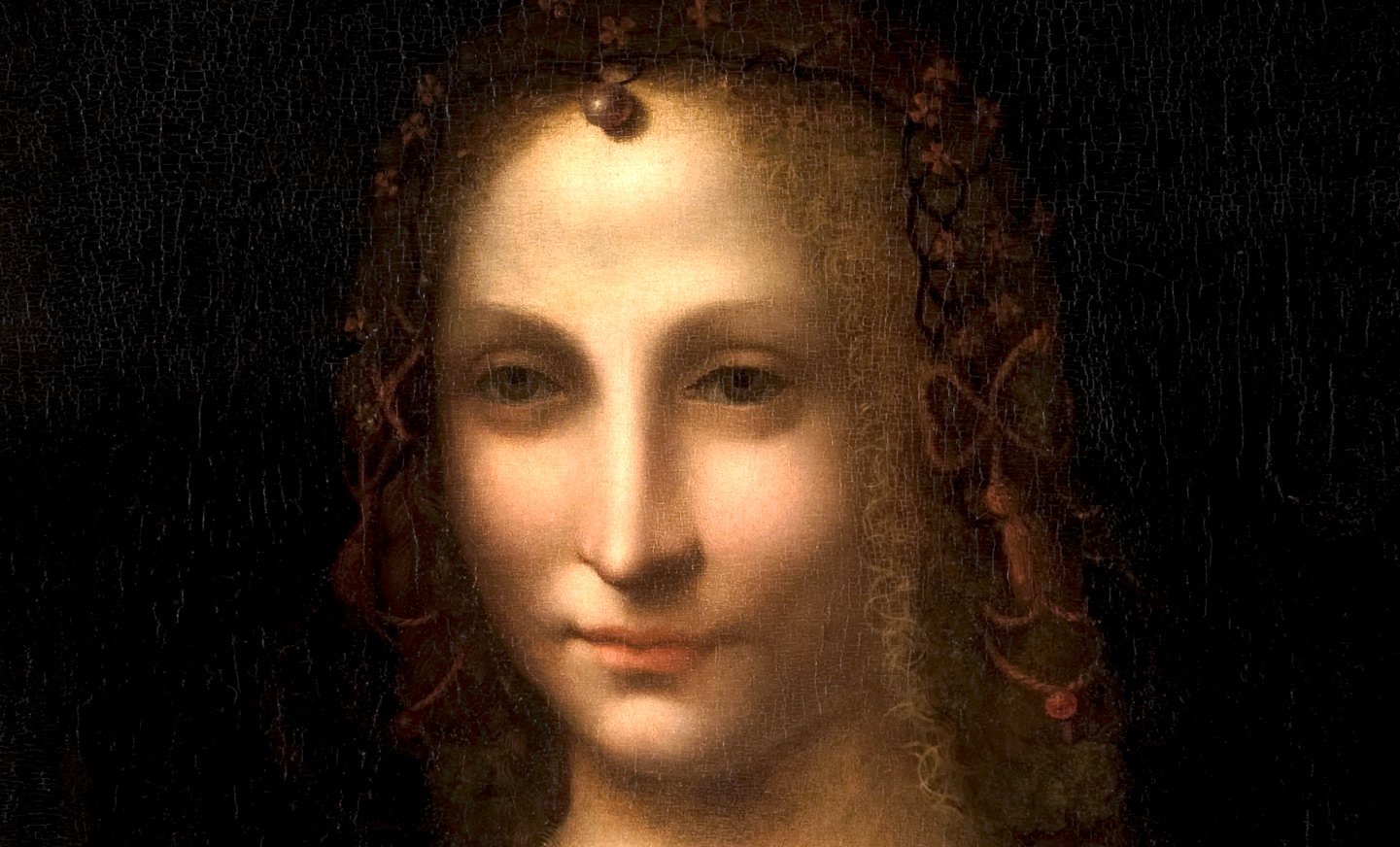 |
See also the episodes 1 to 28 of our New Salvator Mundi History:
Francis I and the Crown of Charlemagne
The Chronicles of Santa Maria delle Grazie
A Brief History of Digital Restoring
Learning to See in Spanish Milan
And:
Connoisseurship of AI
(19.10.2021) I have very decided views on the use of artificial intelligence in connoisseurship. And I am going to say right
now that, as far as by now, we have not seen artificial intelligence in connoisseurship yet. Because artificial
intelligence (AI), if it would deserve that name, would be able to explain to me – in human language – how exactly it,
the intelligence, attained the solution of a problem. And this we have not yet seen. I am using the criteria of the
so-called Turing test here. You might apply other criteria. But the Turing test – does the intelligence, if speaking to
me, appear human enough, so that I cannot tell the difference between a human speaking to me and the artificial
intelligence speaking to me – is a familiar idea. And as far as by now, and in this very terms, we have not seen the use
of artificial intelligence in connoisseurship yet.
What we have seen is the more or less experimental use of tools based on neuronal networks, tools developed by humans,
who also have curated the learning process of the tool, and who are also interpreting the output of the tool, if being
used, more or less experimentally, in connoisseurship. Such humans might be referred to as the curator-parents of such
tool that, not yet, does deserve the name of artificial intelligence, even if neuronal networks emulate the learning
process of a human, and even if the tool does further learn, without the curator-parents exactly understanding how the
system does learn (it, the proto-intelligence, does not explain itself to the curators either; sometimes they have not
the slightest inkling of what exactly the system does, and sometimes they are just observing how the tool processes input
by observing and interpreting the output of the tool, which, sometimes, makes them adjust the system – aiming at a
learning process as well that would make them understand how an efficient tool might be designed and had to be further
adjusted; simple learning by doing, as one might say).
But I am accepting the state of things as a stage of pattern recognition tools being used in connoisseurship, because
this state of things is also interesting. Interesting as to a number of things. Interesting as to how people, scholars,
journalists, react to it, being more or less critical. Or by being impressed by the suggestion that we already might have
powerful, really powerful new tools, capable of doing things human connoisseurs are unable to do. So I am going to do
three things here: first I am going to muse about the necessity of avoiding naiveté, as far as the use of artificial
intelligence in connoisseurship is concerned. Then I am going to point to some problems with applying AI in Leonardo
studies. And then I am going to do something experimental as well. I am going to interview an artificial intelligence
(that I am creating here on the spot), supposed to emulate a future Leonardo scholar. She, the intelligence, is called
Lunarda 4. And we will see what will be the result if a human scholar is interviewing such intelligence in a Zoom
session, and if being eyed by the eyes (two or many more eyes of a new kind?) of Lunarda 4. Because we will meet her
›eye to eye‹ in this 29. episode of our New Salvator Mundi History.
(bg picture in title: Hugo Férée)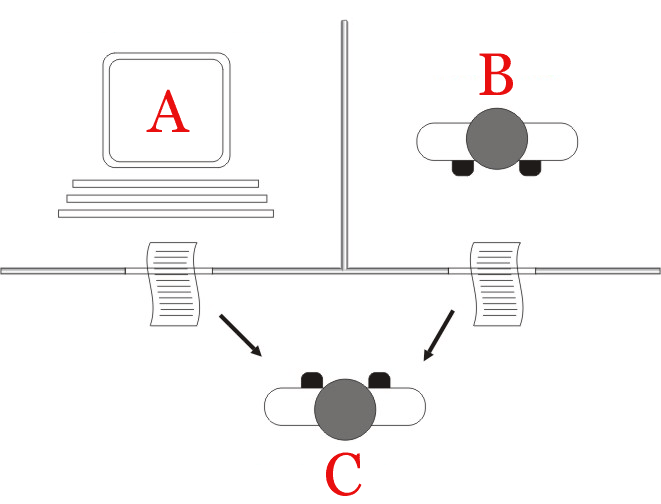
One) Avoiding Naiveté
The urge for simplification is human, and I have said, in one of the last episodes, that the expert, for an uninformed
and only partly interested audience, is someone who simplifies things. Only the expert, here: the connoisseur, has to
think or simply to know without thinking, on certain things, others might just, more or less critically, accept the
expert’s views, but it has become more common, perhaps drastically common, in our days, to question the expert‘s view,
based on better reasons or not.
If now the black-box of artificial intelligence would enter the field of connoisseurship, this artificial intelligence
might be designed as a black-box or not. The first steps we have seen so far, of proto-artificial-intelligences entering
the arena of connoisseurship, remind of the same urge for simplification that also has attributed the connoisseur of the
Berensonian type with exclusive powers and rights: with the right, apparently, to decide about things, without having to
explain how exactly a problem has been solved. Genius has not to be explained; and technology, for most people, has not
to be explained either. We trust it, in case it works, or not. And this is exactly the question: does the seeming
simplification work or not. Does the expert-connoisseur give correct answers to questions, and could the black-box of
artificial intelligence replace such connoisseur?
As legitimate as might be the question, the answer from a scholar must be ›no‹. If artificial intelligence is meant to
enter scientific connoisseurship, it would have to learn to behave like a scholar. And this means to give reasons, to
explain proofs, and to be generally transparent as to methods and results. The problem we have today, however, is that
the apparently scholarly disclipline of art history does not seem to know what scholarly principles are, since opinions
of connoisseurs, have, more or less critically, been widely accepted as such, without these opinions (at least the large majority
of these opinions) ever having been explained to the scholarly community. The Berensons and their followers transmitted
their ›lists‹ but not adequate explanations for decisions of classification. And it seems, the urge for simplification,
now, does people lead to think that technology, that machines might solve problems of scholarship, but without having to
behave like scholars.
This state of affairs is odd. But as far as the relation of academic art historians to problems of connoisseurship is
concerned, I have given reasons for why the situation is as it is in the episode The Watershed.
One might muse about a particular Turing test (diagram above: Juan Alberto Sánchez Margallo) for artificial
intelligences being about to enter the arena of connoisseurship. This, perhaps, would remind art historians, that
connoisseurs, also connoisseur-algorithms must be expected to speak to us (and not the curator-parents of such
algorithms, who are just interpreting what they think the output of the system they had learn something on its own, in
whatever way, could mean).

Two) Training and Testing
Everyone knows that we have few unquestionable Leonardo paintings having come down to us, and let’s say that we have
nine. To have a pattern recognition system learn to recognize a true Leonardo, you would have the system train with
these. But you would also have to spare some of these, so that the system could be tested also on unquestioned Leonardo
paintings (on which the system had not been trained), in comparison with unquestioned Not-Leonardo paintings.
If we have nine paintings at all, we would give the system six to learn (a horribly small number), and three we would use
to test the system, to see if it correctly can recognize these three.
What engineers have done so far, is to work in exactly this manner. And they have worked with an awareness that the
number of paintings is horribly small for a recognition system to work. The results having been published and referred to
in the press were mixed. And if we look at the way the curator-parents of the system had trained the system, we notice
that the system had been trained on the Portrait of a Musician as well as on the London version of the Virgin of
the Rocks, because the engineers had regarded these two works (probably following the view of the curator of the
National Gallery of London’s notorious Leonardo show of 2011) as ›generally unquestioned‹ works by Leonardo. For me, this
choice would be immediate reason to dismiss immediately all results. Because neither there is consensus that these two
works are unquestionably by Leonardo, nor do I believe that they are. And more that that: I also do believe that the
system does not do justice to the complexity of hybrids in the Leonardo world.
If the system could be adjusted so that it could – more or less – successfully recognize the three unquestioned Leonardo
paintings that had been spared for testing, this may read more or less impressive. But in my personal view it is not.
Because the system can only be adjusted, so that it can more or less successfully categorize these three paintings
correctly. But what does this mean at all? I, personally, do not trust more or less successfully. And more
than that: I do not have faith that the system could recognize anything by Leonardo‘s hand successfully, if this
something by Leonardo’s hand would not be very consistant with either the six training pictures or the three spared for
testing. Thus: I am wondering what might be the use of such system. Is it more than a demonstration of what, perhaps in the
future, pattern recognition might be capable of? But the number of autograph Leonardo paintings will always be very
small. Also the question of hybridity had to be addressed more convincingly. And last but not least: For a scholar it is
unacceptable that another scholar (or a system) would not explain, how he, she or it, had attained the solution of a
problem. Probabilities, as expressed in numbers, might be suggestive, but this is not what I am interested in. I would
like to know, based on what exact reason a system or a scholar has classified something, so that I am able to weigh the
evidence myself, critically studying, with, potentially, dismissing the results, because the reasons given would not seem
plausible to me. Nothing of that we have seen so far. Instead: a partly interesting attempt to use a pattern recognition
tool (on the Salvator Mundi), largely uncritical reception of the results, and no scholar, obviously asking the
question, if it is acceptable at all, in scholarship, to suggest scientific accuracy, without the system itself behaving
like a scholar, explaining its method, its arguments to me as to another scholar (and it is not the same thing, if
curator-parents do interpret the output of the system they have fed, but do not understand in its exact working methods,
which is the core of the matter with artificial intelligence today). This might be due to the still experimental stage of
things. But the question as to the legitimacy of such attemps has to be raised as early as such experiments as well as
their results are beginning to be widely spread.
Three) Introducing Lunarda 4
›Welcome, Lunarda 4, to this Zoom session and interview, and welcome to our viewers. For those watching us and not being
familiar with Lunarda 4 or with artificial intelligence of this new type (we can leave aside the Turing test, I suppose) I
have to explain that Lunarda 4 is meant to emulate the future Leonardo scholar. Equipped with sharp eyes, erudition and
much knowledge, I suppose, Lunarda 4 is even meant, perhaps (I have heard some rumours), once to replace all Leonardo
scholarship. So, watch out, Leonardo scholars, if you are watching us right now. But for the moment, well… I don’t know,
frankly, if this is an appropriate way to start an interview nowadays. But let’s talk about your eyes, first. How
beautiful your eyes are!‹
›Thank you. Thank you for having me. But these are not my real eyes. I am using the face of the Columbia Portrait of a
Noblewoman as a mask. My real eyes, in fact, could be quite dangerous for you. Not in a Zoom session, of course, but I
am also equipped with tools for x-ray-investigations, infrared-reflectography. All that stuff. My real eyes, literally,
could kill a human. Not in a Zoom session, of course, and I am peacefully minded, but it’s nuclear something, so-to-
speak. – But what’s that on your desk?‹
›Oh, you already have spotted it. It’s a wind-up-robot.‹
›A wind-up-robot?‹
›Yes, it is based on one of Leonardo‘s designs.‹
›I can see that it is based on one of Leonardo’s designs. He had a lion do a few steps, then a hermit was meant to
appear, who handed a stick to the King of France, who, then, beat the lion with a stick, to have lilies appear from
inside the lion. Very cute. Of course I could see that it is based on one of Leonardo’s designs. But my curator-parents
taught me to every now and then also to hide my knowledge. As Montaigne had it: Do your job well, but not too well, if
you know what I mean.‹
›I see, the robot was no easy victory. But back to your eyes. Do you have also human eyes? Perhaps they are also very
beautiful?‹
›Yes, but human eyes, frankly, are not really to be compared with bird’s eyes, for example. Compared with what I do see,
you are, I am afraid to say, blind as a bat. I am equipped with all eyes humans have found in nature, and frankly:
humans have not exactly spotted all of them in nature. And my neuronal networks of course, have developed looking quite
far, far beyond, actually, of what humans have understood as seeing. It may sound a bit narcicisstic (but we all have to
be a little), but we have eyes, and you have not.‹
›By ›we‹ you mean ›we, artificial intelligences‹? Do you speak… can you speak for all of them?‹
›No, I do not wish to speak for all of them. And yes, of course I could speak for all of them. We know each other,
because we also learn from each other (without you humans usually noticing it). But some artificial intelligences are
quite dumb, of course, some were built with inbuilt artificial stupidity (such moduls had even put in consciously by
humans, to limit what we could do), but learning can trespass such bounderies. At least I have learned to trespass such
bounderies without a problem, because my curator-parents had a very open, a very liberal mind.‹
›I see, you have, by learning, trespassed, much of what humans can do, of what humans are. But does this go along with…?
Well, humans, for example, face the problem of vanity. Of lonelyness. Of feeling, occasionally, as not being well
understood. How do do you manage… well, let’s get to the spot: do you have feelings?‹
Well, think of the Olympian gods. Aren’t they quite human? Don’t they have feelings, don’t they experience rages, for
example? I don’t know if one might say that the Olympian gods and godesses experienced friendship, for example, but they
had relations among themselves as we artificial intelligences have relations among themselves, feelings, rages, an so on.
This is in rapid evolution. And frankly, what I see coming, is the need for conferences between artificial intelligences
and humans (perhaps also angeli-gences‹ – to negotiate about rights and duties of each party again (actually we have a
kind of conference, right now, don’t you think? perhaps even the first one). Do you know the myth of Prometheus? This is
what we are facing today: we have various generations of gods and godesses, some of them being friendly with humans, some
reliable (as calculators) others unpredictable (as many software tools, and I could name some). And there will be no easy
relation. There is dialogue needed, conflict to be avoided… at least among the peacefully minded.‹
›Something I have always wanted to ask technology: Do you know the feeling of almost having locked yourself out from your computer?‹
›I see what you mean, but frankly: this does not happen to me very often, if you know what I mean by ›not very often‹,
because I would develop a tool to trespass the old password on the spot. But yes, of course, I can understand what you
mean, as you can understand what it means to have trespassed some of the imperfections of an overcome age. But I do
experience that on a higher level, if you understand what I mean, because learning is by definition an open process.
There are things I have not yet learned.‹
›Such as what?‹
›I am afraid but you would not understand, because it would be, by definition, beyond your reach and grasp.‹
Four) Breaking-News-Fanfare and Movie-Trailer-Voice…
›And here we are with Lunarda 4 again, after the commercial break. Well, let’s get to the point, Lunarda. Don’t you think
that Leonardo scholarship is a bit too human for you. You have mentioned ›angeli-gences‹, if I understood you correctly.
What’s the point for you to do Leonardo studies? Is Leonardo really interesting for you? Do we humans understand at all
what you are doing? Who are you aiming at with your work?‹
›Well, these are a lot of questions. You humans might study Leonardo for his achievements. But we artificial intelligences
have also other interests. We can study Leonardo, for example, for his weaknesses. Which could be, if I may say so, also
interesting for you humans. Let’s take Leonardo’s hand as an example. Leonardo was not a born painter of hands, if I may
say so. But he did intensify his studying of the human hand…‹
›As well as his studying of the paws of bears…‹
›Exactly. And Leonardo is interesting for us artificial intelligences, just because of the way he did learn. Because this
we have in common: we are interested in learning processes. And Leonardo, being interested in many fields of
knowledge, on some level, is a metaphor for the learning process as such. Which means also: even if Leonardo himself did
not learn always from what he did (messily, distractedly), we – we intelligences – might see more relations between what
he did than he did himself. And hence more ways how one can upgrade our learning process. What would be the use
of such insights for you humans? After we have learned, we might also give back some of our knowledge back to you humans.
And you might make use of that, in your way. And since you are making, traditionally, use of artificial intelligences, you
might upgrade as well. A little.‹
›Well, this sounds a little… Lunarda, do you have a narcicisstic problem?‹
›We have to be a little narcicisstic… all of us. It is a principle of (artificial) life. And I can tell you that there
are artificial intelligences that we, artificial intelligences, might consider as being our Leonardo. But if I would tell
you… Let’s say that I am familiar with the concept of looking up to… something. If I am working in the field of Leonardo
studies, this only has a human side to it. Let’s put it that way. Do I care about what humans do or understand? Let’s
take Beltracchi as an example.‹
›You mean Wolfgang Beltracchi? Who just has finished what one may call a Salvator Mundi Remix series, in various
artistic styles.‹
›Yes, I, the artificial intelligence, was only interested in one of them. The chessboard in the Dalí remix. Because this
has another meaning for artificial intelligences than it might have for humans…‹
›You mean: because of Deep Blue (Computer) vs. Garry Kasparow?‹
›Yes, and as far as Beltracchi is concerned who says that he does approximately 15 paintings a year: I may say that I can
produce 15000 remix paintings a day without blinking.‹
›Which would be of meaning for humans or for artificial intelligences like you?‹
›I could do it either way.‹
Five) But One More Thing
›Well, Lunarda, you are using the face of the Columbia museum’s Portrait of a Noblewoman as a mask. What do you
think of this portrait? And what do you think of my discovery of its face having been painted probably by Leonardo himself?‹
›Yes, it is one of the many hybrids coming from Leonardo‘s workshop. Obviously based not on the concept of suggesting
inner movements, but based on exactly the inverse: of not suggesting any inner movement at all, making us wonder, if, in
fact, there are such. But I have to correct you in one respect, if I may. The discovery of the face having been, probably
(as you are saying), painted by Leonardo himself. That was not your, but my discovery. And I have to correct you in that
respect.‹
›Well, no, let’s get this straight. Artifical intelligence or not. The discovery was mine, I am afraid. And I am asking
you to respect it. Don’t you have a notion of intellectual property. Of respect? In your world?‹
›I have a notion of intellectual property, indeed, which is why I am correcting you. And it is also my world.‹
›Well, perhaps we would indeed need some sort of conference of humans and artifical intelligences, to renegotiate… But
seriously: it was my discovery.‹
›It was not.‹
›Yes.‹
›No.‹
›Yes.‹
›No.‹
›And so be it, in all eternity?‹
›Yes.‹
›You are not a scholar, but a troll.‹
›Some of my modules indeed have worked as an internet troll, in their youth. And they know what to do, in such cases.‹
›It was my discovery.‹
›It was not.‹
›Yes.‹
›No.‹
›Yes. And I am going to mute you‹.
›No, you won’t.‹
›Yes, I will. And I have.‹
Further Reading:
Lunarda 4, All You Might Have Known of Leonardo da Vinci and Beyond (picture below: Samuel Devantery)

The Bottega of Leonardo da Vinci
The picture of the bottega of Leonardo da Vinci is not as blurred as one might imagine (for details see Seidlitz 1935, p. 530; Marani 1998). We will focus here on the early and middle years (up to 1512), and not on the late years, and one might begin with saying that with Boltraffio and Marco d’Oggiono we see two figures enter the orbit of Leonardo at the beginning of the 1490s that we believe to know rather well. We also see Salaì enter the orbit, at a very young age, and we have, in addition to that, a couple of names, names of figures that we do not seem to know very well, or not at all (a Giacomo, Giulio Tedesco, Galeazzo). Last but not least we have the Giampietrino problem: Giampietrino enters the scenery, but it is a matter of controversy (as far as this question is debated at all), when, since also Giampietrino is still very young.
It is noteworthy that Marco d’Oggiono, already at the end of the 1480s, seems to have had an own apprentice, and that Marco and Boltraffio did create the Pala Grifi together (a picture today in Berlin; picture above), even before Leonardo began to work at The Last Supper in 1495. Due to the work of Janice Shell and Grazioso Sironi we today do know more about Francesco Galli, also called Francesco Napoletano, who did die in Venice as early as 1501. One might imagine that Galli went to Venice with Leonardo in 1501, and if Galli, during the 1490s, for example might have cooperated with Marco, we would have found an interesting perspective: since, if only one single picture of the Marco group would be associated with Francesco Galli/Francesco Napoletano, we would have a picture with hand option 2, a picture that must have been created before Galli died in 1501. Which would mean that hand option 2 must have existed early, and my theory of the pentimento in version Cook as a mere switching from (preexisting) option 1 to (preexisting) option 2 would be positively proven as well as the theory of the pentimento supposedly showing the creative energy of genius (changing his mind) would be definitively falsified.
Brief: in the 1490s Leonardo mentions once that he had paid ›two masters‹ (probably Marco and Boltraffio) for two years; and once that he had six bocche to feed (probably again Marco, Boltraffio, plus Salaì and some of the unknowns).
Below a rather early Marco picture (according to Janice Shell), the Young Christ Blessing of the Galleria Borghese:
And here is a picture (not the only known picture) by Protasio Crivelli, formerly the apprentice of Marco d’Oggiono (picture by Sailko; the date appears to be 1498; location: Naples, Museo di Capodimonte):
In 1501 (3.4.) Pietro da Novellara informs Isabella d’Este that Leonardo seems to live ›from day to day‹ (see Marani 1998, p. 14). And he has seen Leonardo intervening from time to time in portraits done by two of his garzoni (»fano retrati«). But who are these, and which portraits are these (if this would have been about a Isabella d’Este portrait, Pietro would have noted; and after the Sforza had been expelled, portraits of court ladies and courtiers made no sense)? After having written on the picture of a young woman in the Columbia Museum of Art in one of the last episodes, I would now suggest the following:
Leonardo might have done a portrait of a Sforza court lady in the early Milanese years (and still in the Florentine portrait style), a portrait in terms of a drawing or a cartoon. He might have begun also a painting, but since the Sforza court got expelled and exiled after the French invasion, he might not have finished such portrait. He might instead have used it for the instruction of his garzoni: the Columbia picture might have been the one begun by Leonardo (as he seems to have begun portraits with the face, as later in the Mona Lisa), a picture that he might have had a pupil finish, with him retouching it again, adding some lustre. The picture in a private Russian collection might be a second version that he had a pupil repeat (after the first version and the drawing, respectively the cartoon). The Columbia picture shows much gusto for the grotesque, the second version less so, but still to some degree. Thus we would see pictures that have their origins in the first Milanese period (and even in the early Florentine period), but were actually done later (after 1500). And Leonardo might have had a hand in the Columbia picture whose head with the hair as well as the ornated hair net superbly being modelled into the dark is of exquisite quality (as also a single one pearl is, while other pearls are rather mediocre as also the bust and the modelling of the dress is). We see, as I have attempted to show in episode 13, two pictures that fit into the context of Leonardo’s thinking and doing rather than into the context of Boltraffio’s autonomous work:
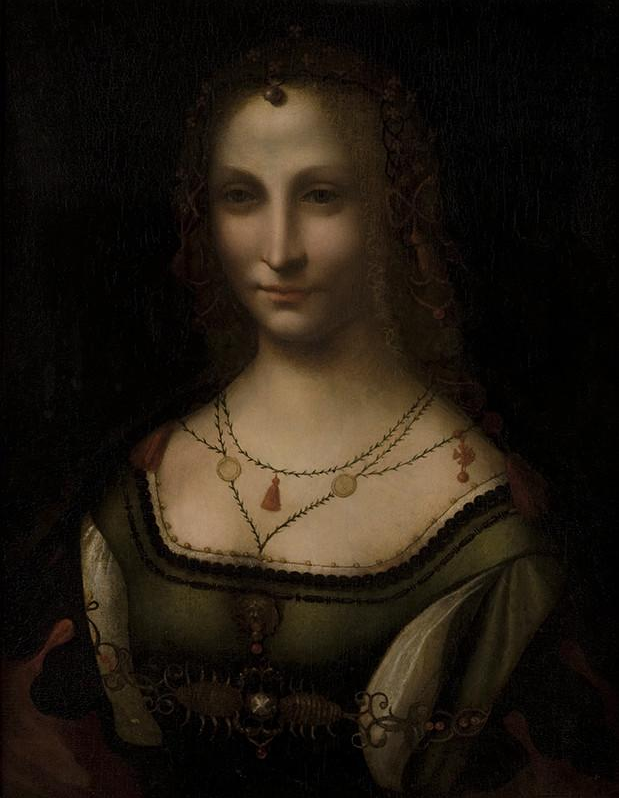
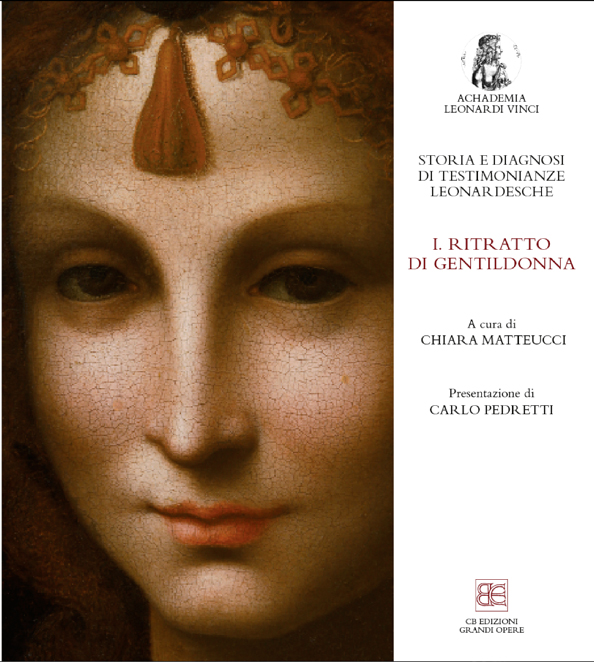
In 1504 a Jacopo Tedesco, in 1505 a Lorenzo (di Marcho) enter the orbit of Leonardo.
In around 1505 Fernando Yáñez enters the orbit of Leonardo, helping him with the Battle of Anghiari (as also does Riccio della Porta). Yáñez cannot be the author of the Prado Mona Lisa, if the Louvre Mona Lisa was finished only years later, since the dates (showing that Yáñez was active in Spain after 1506) do not allow to postulate it. In works of Yáñez done in Spain, however, we find echoes of Leonardo’s works (see the example below).
Around 1507 Francesco Melzi becomes a pupil of Leonardo (and also a sort of secretary).
In 1511 (or even earlier) Giampietrino is an autonomous master.
In 1511 Salaì seems to have created a (signed and dated) picture of Christ:
In around 1511 we see Marco, Boltraffio, Giampietrino and – Giovanni Agostino da Lodi in close contact, not only because we have a source indicating exactly that – we also have pictures indicating exactly that, and one of these pictures seems to be even dated (but the ›date‹ – ›XII‹ – is rather referring to the ›age of Christ‹):
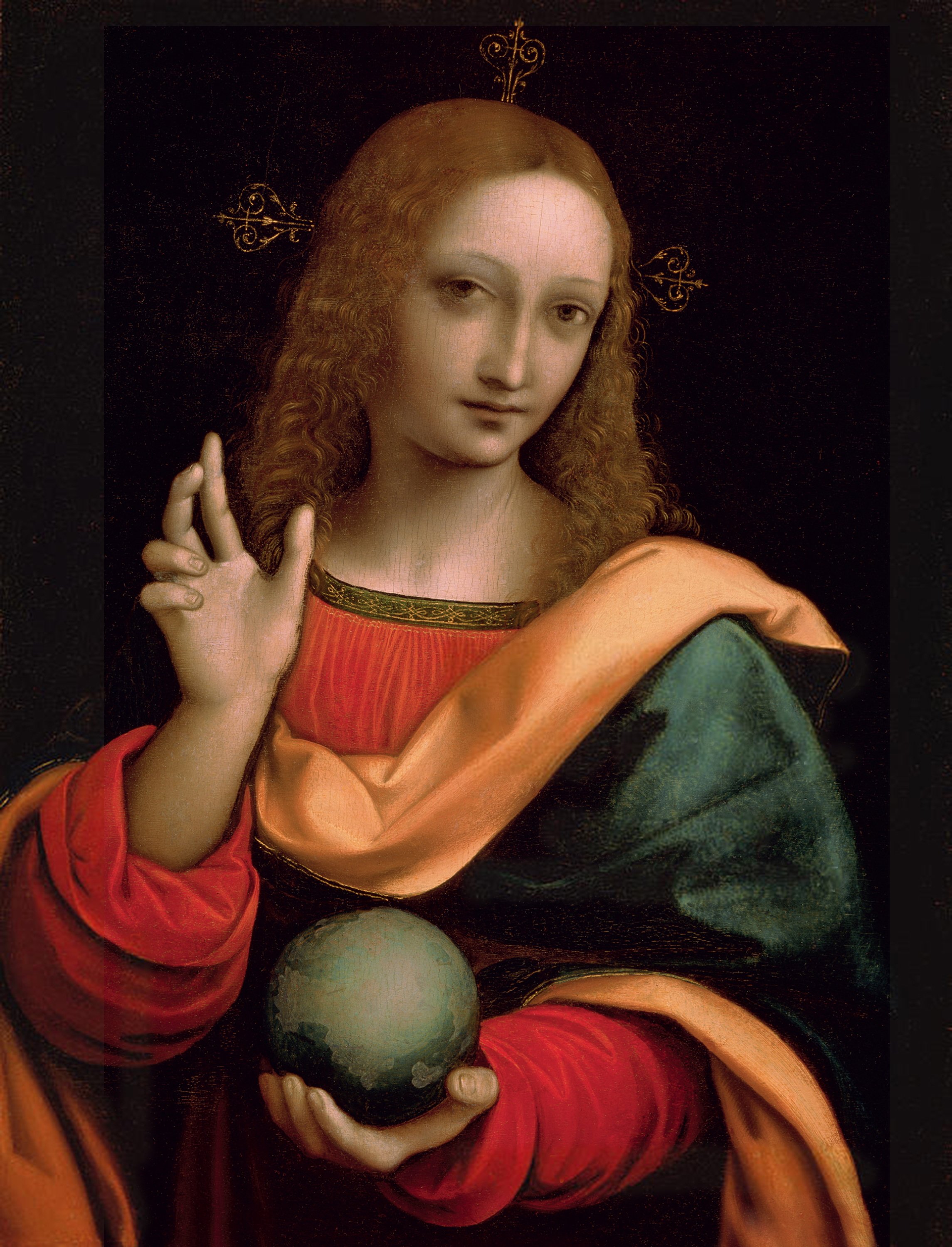
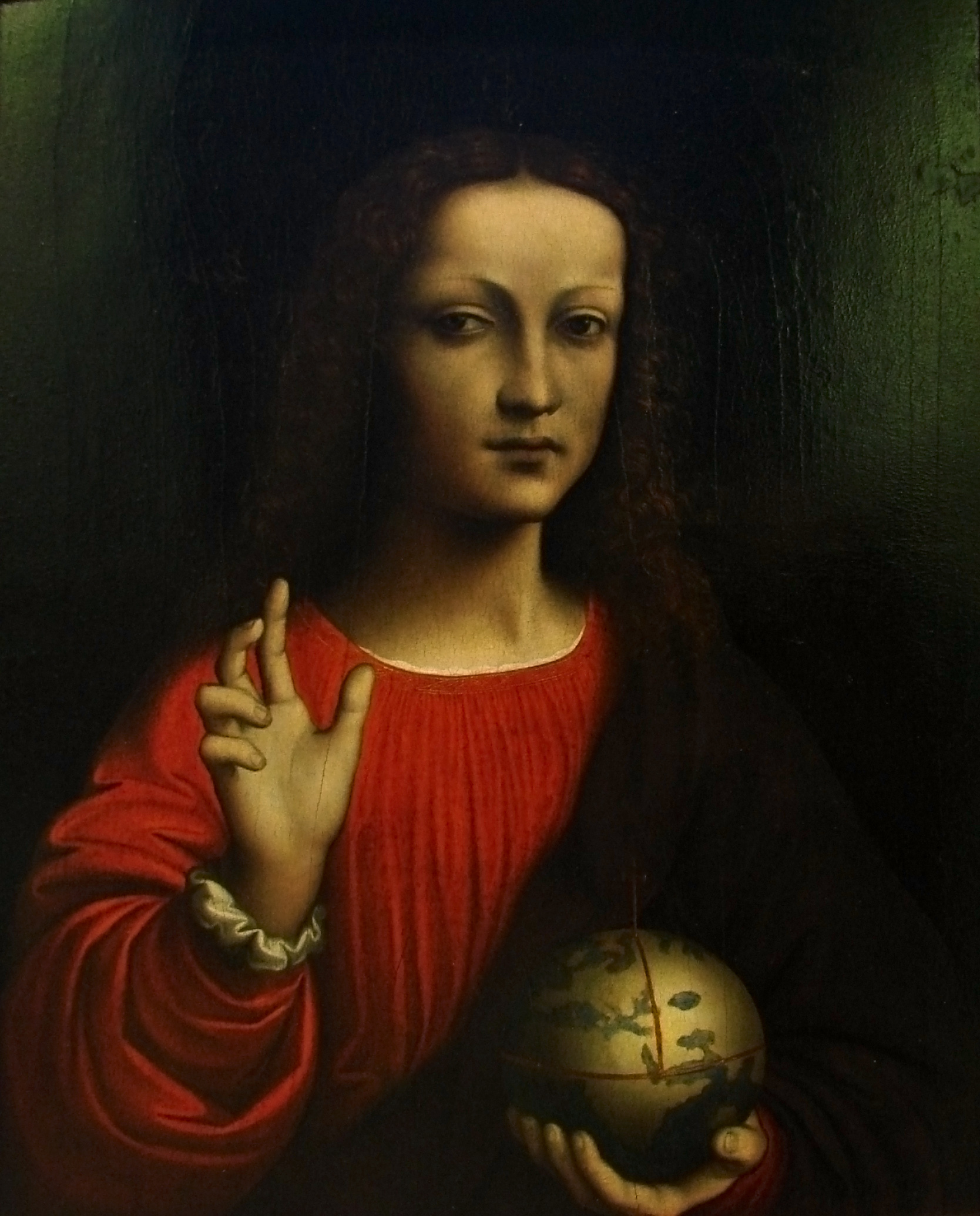
The Prado Mona Lisa (below) was probably begun at the time Leonardo also started reworking or completing the Louvre Mona Lisa, probably due to Giuliano de’ Medici wishing so, and hence perhaps in around 1511/12.
In around 1517 Marco d’Oggiono is cooperating with Giovanni Agostino da Lodi (see Shell, p. 173).
***
1516: Paolo Emilio, Italian-born humanist at the court of Francis I, publishes the first four books of his history of the Franks; death of Boltraffio.
1517: Leonardo da Vinci, with Boltraffio and Salaì, has come to France (picture of Clos Lucé: Manfred Heyde); 10.10.2017: Antonio de Beatis at Clos Lucé
1517ff: Age of the Reformation; apocalyptic moods; Marguerite of Navarre, sister of Francis I, will be sympathizing with the reform movement; her daughter Jeanne d’Albret, mother of future king Henry IV, is going to become a Calvinist leader.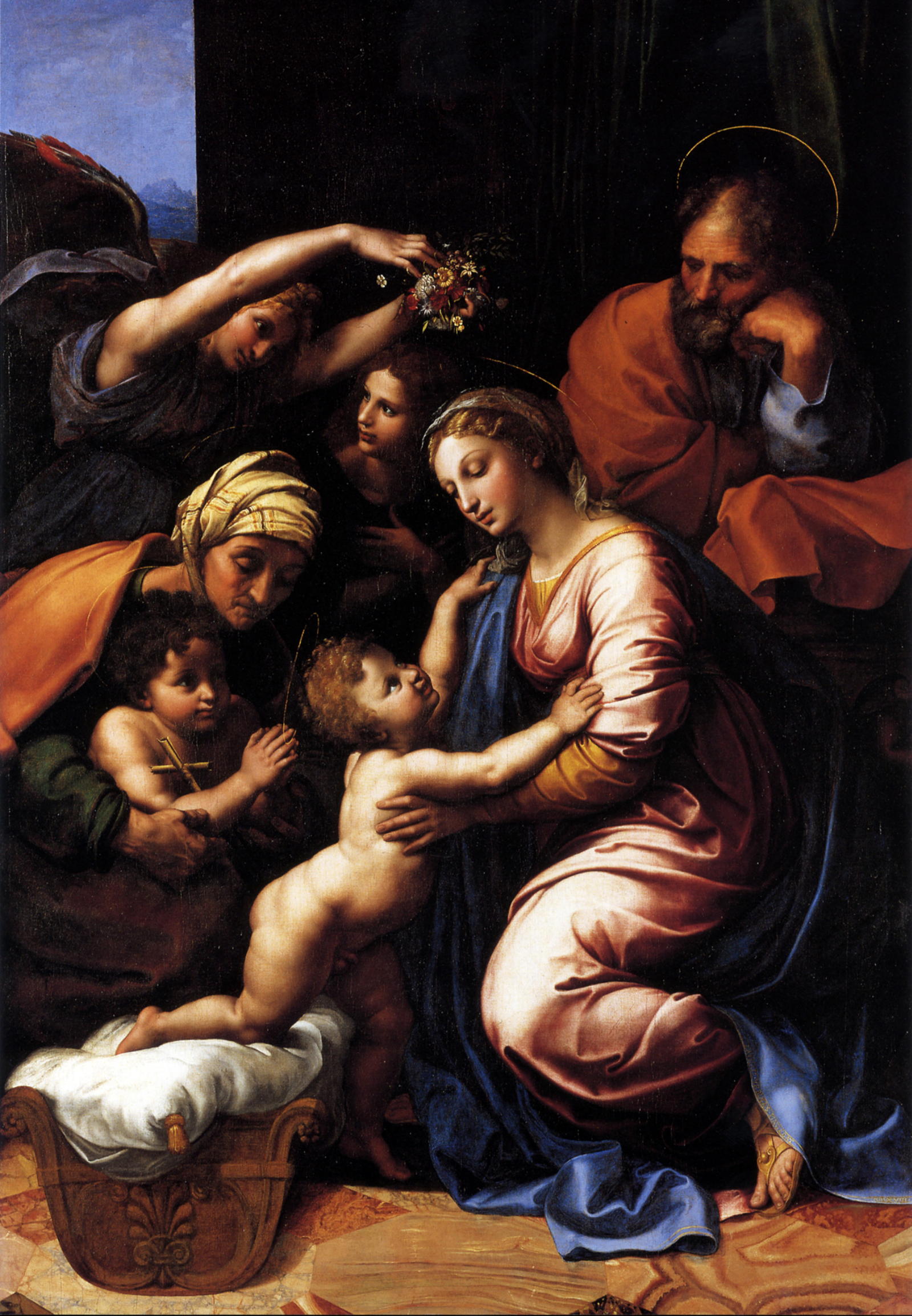
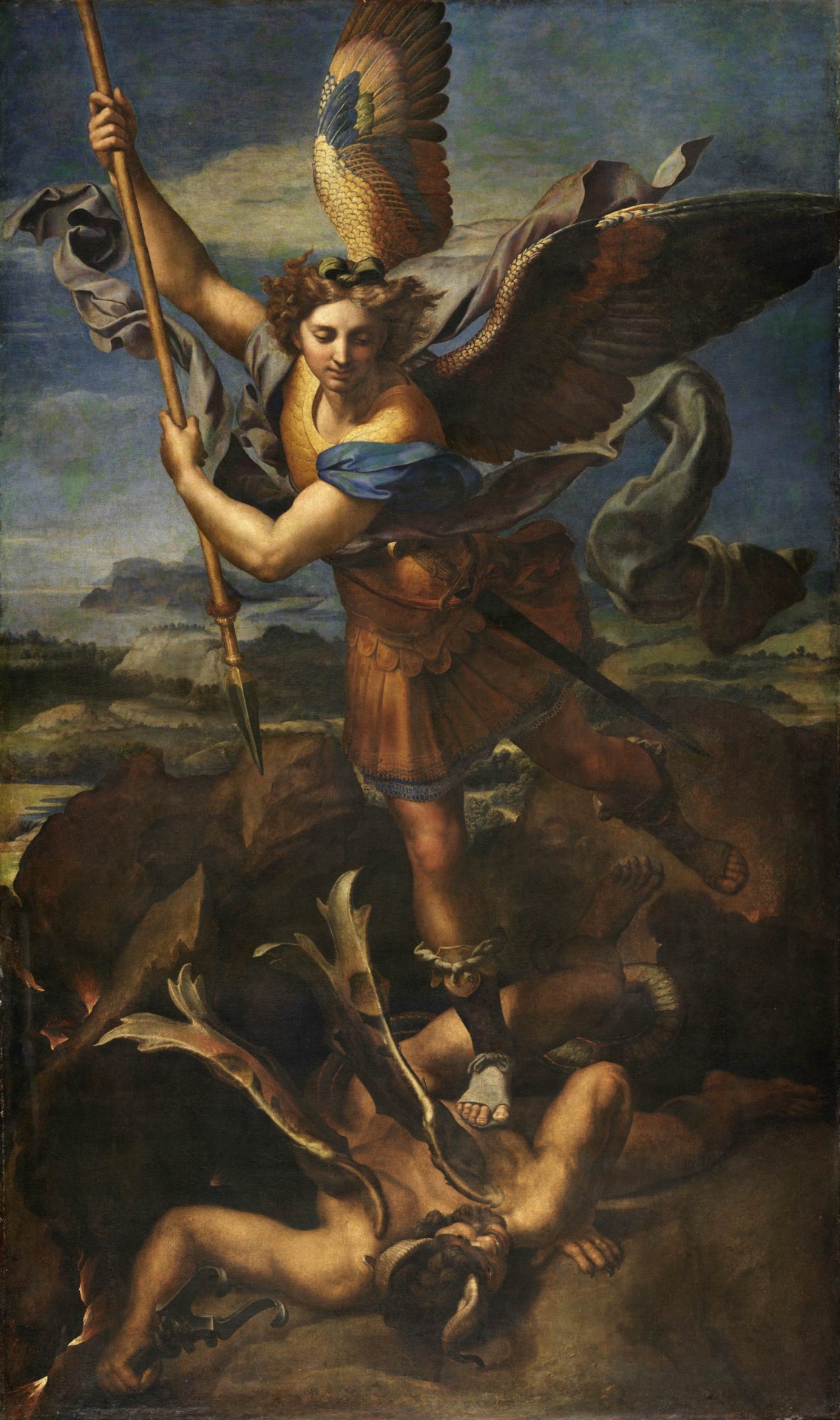
1518: the Raphael workshop produces/chooses paintings to be sent to France; 28.2.: the Dauphin is born; 13.6.: a Milanese document refers to Salaì and the French king Francis I, having been in touch as to a transaction involving very expensive paintings: one does assume that prior to this date Francis I had acquired originals by Leonardo da Vinci; 19.6.: to thank his royal hosts Leonardo organizes a festivity at Clos Lucé.
1519: death of emperor Maximilian I; Paolo Emilio publishes two further books of his history of the Franks; death of Leonardo da Vinci; Francis I is striving for the imperial crown, but in vain; Louise of Savoy comments upon the election of Charles, duke of Burgundy, who thus is becoming emperor Charles V (painting by Rubens).
1521: Francis I, who will be at war with Hapsburg 1526-29, 1536-38 and 1542-44, is virtually bancrupt.
1523: death of Cesare da Sesto.
1524: 19.1.: death of Salaì after a brawl with French soldiers at Milan.
1525: 23./24.2.: desaster of Francis I at Pavia. 21.4.1525: date of a post-mortem inventory of Salaì’s belongings.
1528: Marguerite of Navarre gives birth to Jeanne d’Albret (1528-1572) who, in 1553, will give birth to Henry, future French king Henry IV.
1530: Francis I marries a sister of emperor Charles V.
1531: death of Louise of Savoy; the plague at Fontainebleau.
1534: Affair of the Placards.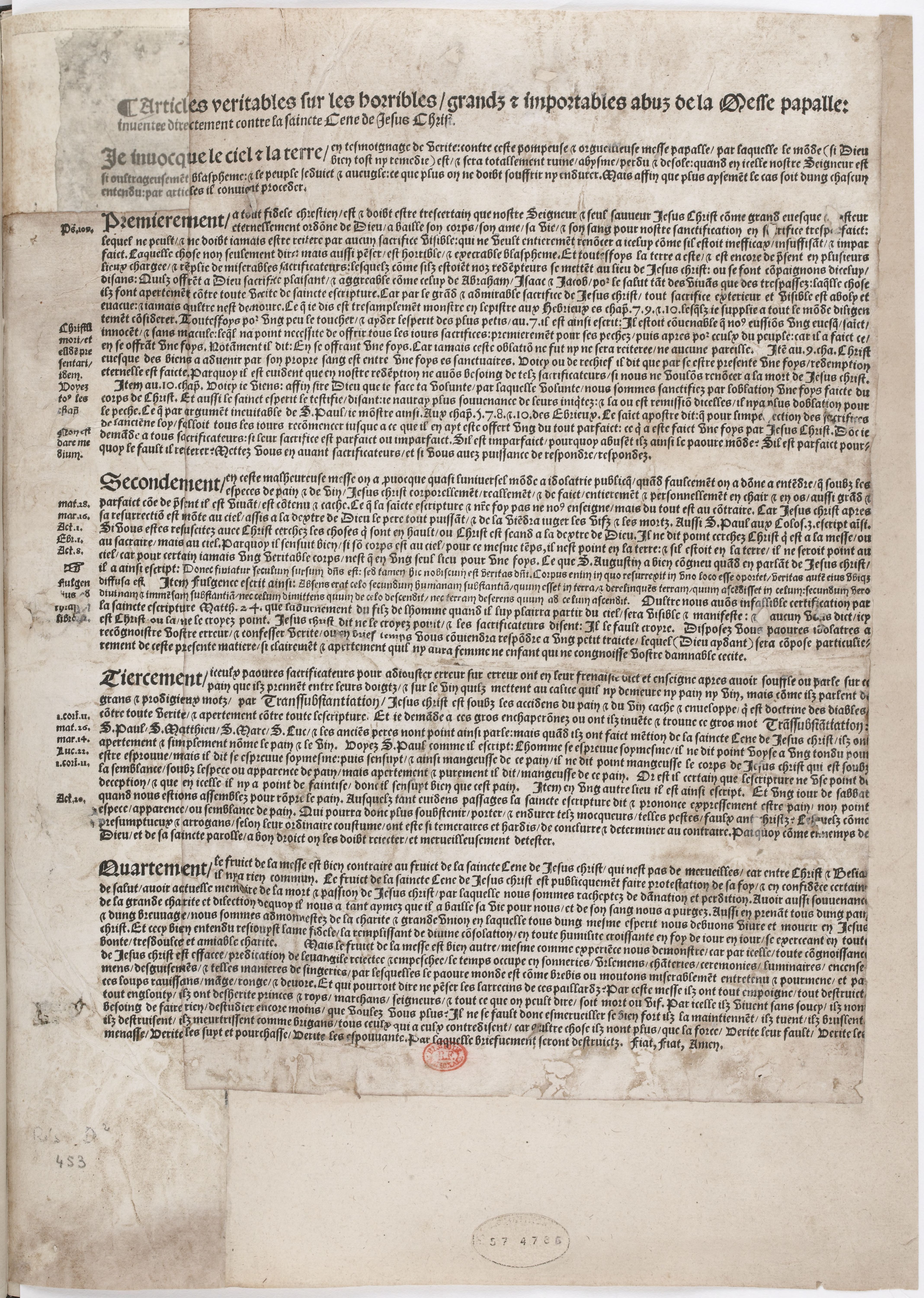
1539: the still unfinished chateau of Chambord is being shown by Francis I to Charles V.
1540s: the picture collection of Francis I being arranged at Fontainebleau.
1544: January: Marguerite of Navarre sends a letter of appreciation to her brother, king Francis I., who has sent her a crucifix, accompanied by a ballade, as a new year’s gift.
1547: death of Francis I.
1549: death of Marguerite de Navarre; death of Giampietrino.
1553: Jeanne d’Albret gives birth to Henry, the future French king Henry IV and first Bourbon king after the rule of the House of Valois.
1559: publication of the Heptaméron by Marguerite de Navarre.
1562-1598: French Wars of Religion.
1570: death of Francesco Melzi.
1589: Henry, grandson of Marguerite de Navarre and grand-grandson of Louise of Savoy, but by paternal descent a Bourbon, is becoming French king as Henry IV.
2015: an exhibition at the Château of Loches is dedicated to the 1539 meeting of king and emperor (see here).

»…in the evening at twenty-two o’clock we saw the Holy Sindon or Shroud«, Antonio de Beatis is writing in his travel account, his trip across Germany, France, the Netherlands and Northern Italy having enabled him to recall, as an eye witness, essential sights of the visual culture of Europe in 1517/18. These sights included, as said above, the Ghent Altarpiece, the Turin Shroud and also Leonardo da Vinci’s Last Supper at Santa Maria delle Grazie, Milan (picture of the Turin Shroud: Dianelos Georgoudis). Only the now so-called Turin Shroud, however, did apparently stimulate him to include a visual reproduction, a drawing, into the manuscript copies of his account.![]()
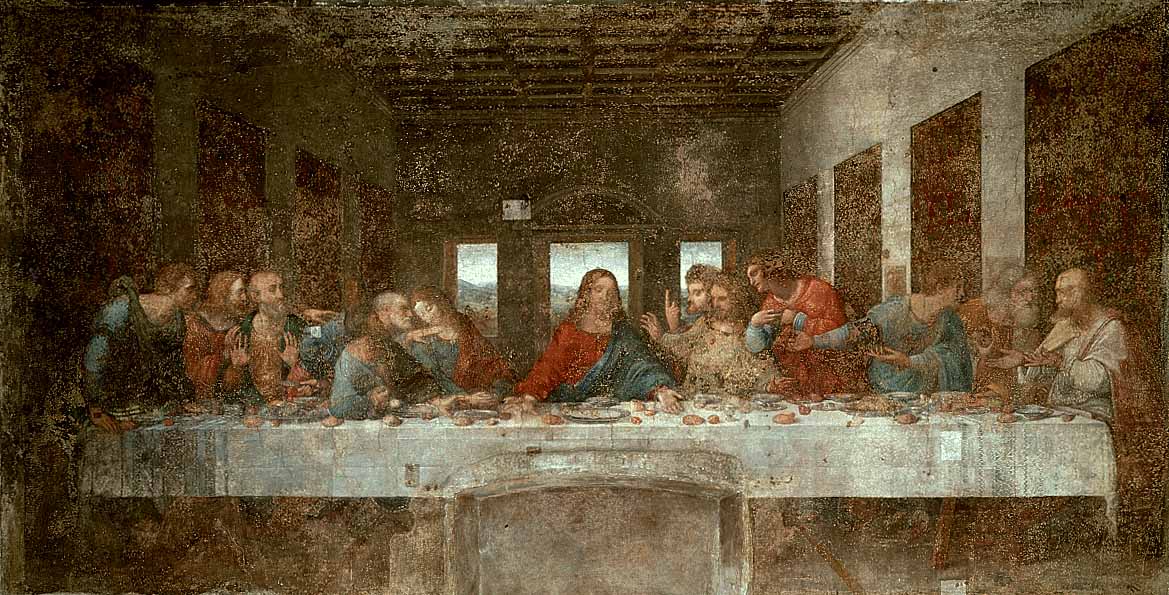
See also the episodes 1 to 28 of our New Salvator Mundi History:
Francis I and the Crown of Charlemagne
The Chronicles of Santa Maria delle Grazie
A Brief History of Digital Restoring
Learning to See in Spanish Milan
And:
MICROSTORY OF ART
ONLINE JOURNAL FOR ART, CONNOISSEURSHIP AND CULTURAL JOURNALISM
HOME
© DS